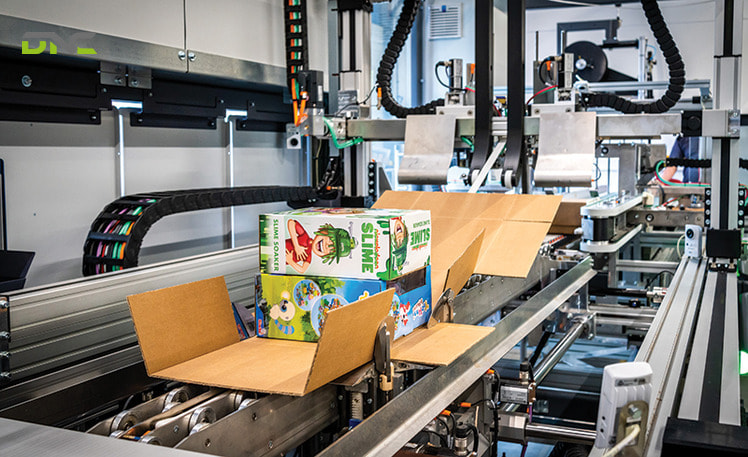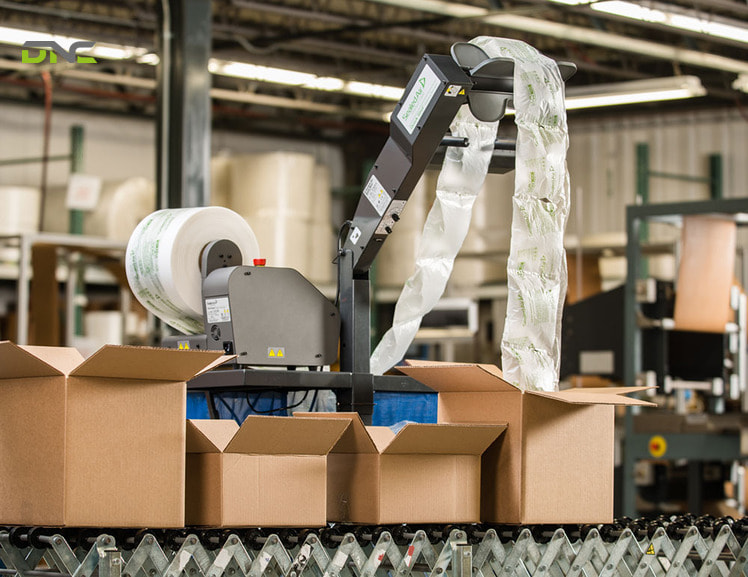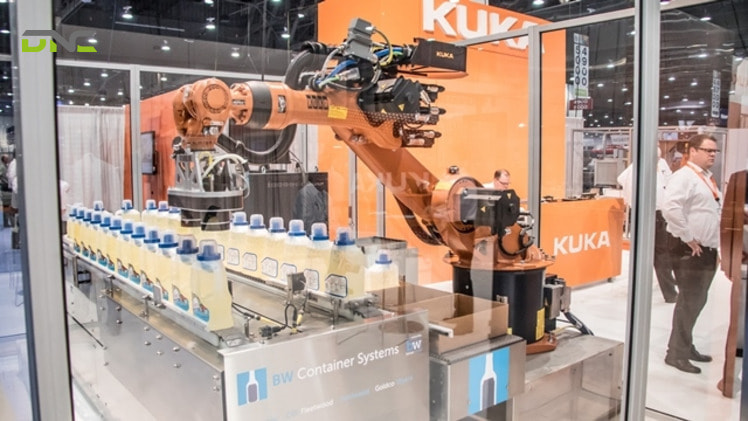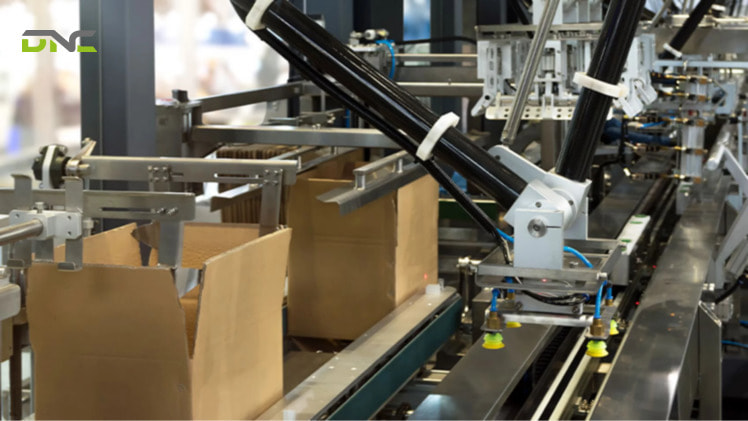PLC Control in Packaging Automation: The Smart Core of Modern Packaging Lines
From coordinating conveyors and sensors to managing robotic arms and sealing machines, PLC control in packaging automation enables seamless operation across the entire line. For manufacturers, this means faster throughput, fewer errors, and real-time visibility into system performance.
At DNC Automation, we specialize in designing and implementing PLC-based control systems that help packaging lines operate smarter, safer, and more efficiently — setting the foundation for Industry 4.0 manufacturing.
Why Is PLC Control Essential in Modern Packaging Automation?
In today’s manufacturing landscape, packaging automation has become a crucial factor in increasing efficiency and product consistency. As factories move toward smarter and more connected production lines, the need for precise and reliable control systems grows stronger.
At the heart of these automated packaging lines lies the Programmable Logic Controller (PLC) — a powerful system responsible for coordinating, monitoring, and optimizing every stage of the process. From conveyor synchronization to machine safety and data communication, PLCs ensure that each component works seamlessly together.
By integrating PLC control into packaging automation, businesses gain significant advantages: higher production speed, reduced downtime, consistent quality, and real-time data for decision-making. In short, PLCs are not just control devices — they are the backbone of modern, intelligent packaging operations.
What Is PLC Control in Packaging Automation?
A Programmable Logic Controller (PLC) is a specialized industrial computer designed to automate machinery and processes within a production environment. In packaging automation, the PLC acts as the “brain” of the entire system, managing and synchronizing multiple devices such as conveyors, sensors, servo motors, robotic arms, and labeling machines.
The PLC continuously receives input signals from sensors and devices across the line — for example, detecting product presence or verifying seal position — then processes this data based on a programmed logic and sends corresponding commands to actuators.

A Programmable Logic Controller (PLC)
How Does PLC Control Enhance Efficiency in Packaging Lines?
As packaging demands grow more complex and production speeds increase, manufacturers face the challenge of maintaining accuracy, consistency, and uptime, all while reducing costs. This is where PLC control proves its unmatched value. Let’s take a closer look at the key benefits of using PLC in packaging lines and how it transforms ordinary production into a high-performance, data-driven process.
- Speed and Accuracy: PLC systems precisely control timing and coordination among machines, allowing faster packaging cycles while minimizing errors caused by human intervention.
- Consistency & Quality: Automation through PLC ensures every package meets the same quality standards — from filling levels to seal strength — resulting in reliable, repeatable outcomes across batches.
- Flexibility: With simple program adjustments, operators can switch between different packaging sizes, materials, or products without reconfiguring the entire system. This adaptability is key in industries handling diverse SKUs.
- Reduced Downtime: PLCs feature built-in diagnostics and fault detection functions that help identify problems quickly. Maintenance teams can act before a full breakdown occurs, improving overall equipment effectiveness (OEE).
- Data Integration: Modern PLCs connect seamlessly with HMI, SCADA, or MES systems, enabling real-time monitoring, performance tracking, and data-driven optimization — essential elements of smart manufacturing and Industry 4.0.

How Does PLC Control Enhance Efficiency in Packaging Lines?
What Are the Core Components of a PLC System in Packaging Automation?
To understand how PLC control drives packaging efficiency, it’s important to know what makes up the system. A complete PLC-based automation line is composed of several interconnected components that work in perfect synchronization:
- PLC Controller – The central processing unit (CPU) that executes programmed logic, receives input data, and sends control signals to various devices in the line.
- I/O Modules (Digital & Analog) – Serve as the bridge between the PLC and field devices. Inputs collect data from sensors, while outputs send signals to actuators, motors, or valves.
- Sensors and Actuators – Detect parameters like product presence, position, or temperature, and execute mechanical actions such as pushing, sealing, or labeling.
- Human-Machine Interface (HMI) – Allows operators to monitor system status, adjust parameters, and view alarms in real time through an intuitive touchscreen interface.
- Communication Networks (Ethernet/IP, PROFINET, Modbus, etc.) – Enable seamless data exchange between PLCs, HMIs, robots, and upper-level systems like SCADA or MES.
Where Is PLC Control Applied in Packaging Lines?
PLC control can be found at every stage of modern packaging operations — from primary processing to final palletizing. Its versatility allows integration with various types of machines and systems, including:
- Filling & Sealing Machines: Manage the filling rate and sealing time with precision to ensure consistent product quality and prevent spillage or leakage.
- Labeling Systems: Synchronize conveyor speed and label application to achieve accurate positioning and reduce waste.
- Cartoning & Palletizing Systems: Coordinate robotic arms, conveyors, and sensors for automated box formation, stacking, and wrapping.
- Inspection & Sorting Systems: Integrate vision systems or smart sensors to detect product defects, misalignment, or missing labels before they leave the line.
By connecting these processes through a unified PLC platform, manufacturers achieve continuous operation, better quality control, and lower production costs.

PLC control can be found at every stage of modern packaging operations
How Is PLC Programming and System Integration Performed?
The true power of a PLC lies in its ability to be programmed and customized to fit any packaging requirement. Engineers use several standardized programming languages defined by IEC 61131-3, such as:
- Ladder Diagram (LD): The most common language, visually resembling electrical relay logic — ideal for step-by-step machine control.
- Structured Text (ST): High-level coding language used for complex calculations and data manipulation.
- Function Block Diagram (FBD): Graphical representation that simplifies control of repetitive or modular functions.
Once programmed, the PLC integrates seamlessly with HMI and SCADA systems for real-time data visualization, performance tracking, and alarm monitoring.
In advanced setups, PLCs also connect to IoT and Industry 4.0 platforms, enabling remote diagnostics, predictive maintenance, and cloud-based analytics — helping factories move from reactive to proactive operation.
How to Choose the Right PLC for Your Packaging Automation System?
Selecting the right PLC is crucial for ensuring system stability, scalability, and long-term performance. Here are the key factors to consider:
- Number of I/O Points: Choose a PLC that can handle the required input/output devices, with flexibility for future expansion.
- Processing Speed: Faster CPUs improve timing accuracy and response rate for high-speed packaging lines.
- Scalability and Communication Options: Ensure compatibility with industrial networks (Ethernet/IP, Modbus, PROFINET) and third-party devices.
- Reliability and Technical Support: Opt for well-established brands with proven durability and strong local support.
Popular choices in packaging applications include Siemens, Allen-Bradley, Mitsubishi, and Omron, all known for robust performance and flexibility across industries.

Selecting the right PLC is crucial for ensuring system stability, scalability, and long-term performance.
Why Partner with DNC Automation for Your PLC Packaging Solution?
At DNC Automation, we understand that every packaging line has unique challenges — and our mission is to deliver customized, high-performance automation systems that meet those needs.
- Proven Expertise: Years of experience in designing and integrating PLC & SCADA systems for factories in food & beverage, pharmaceuticals, logistics, and FMCG.
- End-to-End Services: From consultation, design, programming, and installation to maintenance and optimization, DNC provides a complete automation lifecycle.
- Specialized Engineering Team: Our engineers are trained to optimize system logic, minimize downtime, and ensure reliable performance.
- Commitment to Value: We help businesses reduce operating costs, improve line efficiency, and achieve consistent production quality.
Partnering with DNC Automation means choosing a team dedicated to making your packaging line smarter, faster, and more reliable.
Conclusion
PLC control is no longer a luxury — it’s a necessity for manufacturers aiming to compete in a rapidly evolving industry. By integrating intelligent PLC systems into your packaging automation, you gain unmatched precision, flexibility, and control across every stage of production.
At DNC Automation, we bring deep expertise and proven technology to help you transform your factory into a fully automated, data-driven environment. Contact DNC Automation today to discover how our PLC solutions can elevate your packaging line’s performance and efficiency.
- 6 views
- 0 Comment




Recent Comments